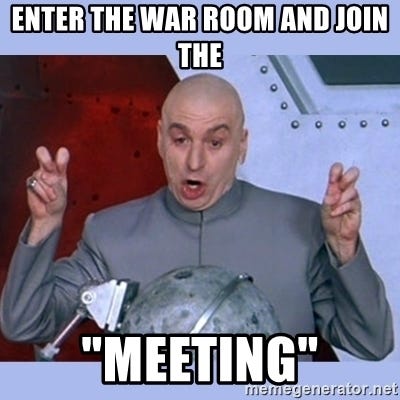If you’re new to this newsletter then welcome! Thank you to the 1,600+ revenue operations professionals who continue to subscribe to this newsletter. You’re the reason I continue to write each and every week on a Go To Market related topic. When I have a template to share paid subscribers will get access. I don’t have all the answers in revenue operations. That’s impossible because RevOps can be uniquely situated for each unique situation. But what I hope you can take away a few guiding principles or tactical snippets which you can use in your day to day. Before jumping into the newsletter, let’s hear from our sponsors that keep most of this newsletter free to readers.Salesforce is powerful and robust. But it wasn’t built to help sales teams identify the next steps to take and guide them on who they need to build relationships with in order to win deals. Prolifiq helps Revenue & Sales Operations professionals solve this gap through strategic account planning and sales intelligence technology.
Most forecasts suck. It’s not just an accountability problem. It’s also an alignment and an insights problem. And those problems affect ALL REVENUE WORKFLOWS including pipeline management. Wouldn’t it be nice to align teams and to hold them accountable with trusted data insights? That’s how you start to boost sales performance with better pipeline management and forecast accuracy of over 95%. Talk to BoostUp
RevOps aren’t system admins. Growblocks is building the 1st RevOps platform, giving you full funnel analytics, continuous monitoring and revenue planning tools - so you can become strategic. Check it out here.
This article is for #startup operators, founders, and leaders. I’ve lived this scenario out a few times. I relish the opportunity to work with young companies to help solve these problems.
So let’s lay out the scenario.
The founder calls a meeting with their executive team. The CMO, CFO, CRO, C-everything-O walks in. Each general is armed to the teeth with narratives, decks, appendices, pushbacks, excuses, solutions, and requests. This is the war room.
For paid subscription members I include a sample Revenue Operating Model (google sheet) below the paywall.
Marketing goes first. Business performance is reviewed. How many leads, conversions, cost per lead. The data portion is over. Next up is the anecdotal evidence. The conversation shifts to highlighting trends, upcoming campaigns, content releases, and community updates. Lastly, issues are discussed with accompanying solutions.
Sales is up next to present. Instead, a clarifying question flies in. The data in marketing’s presentation is questioned. Both leaders entered the room with separate operating models. And they don’t agree with each other.
Everyone needs to be marching to the same destination if the company is going to go up and to the right.
At seed and Series A the focus is on finding and optimizing product market fit. Sometimes a chord is struck and a few paying customers come in. Customers who are friends and family don’t count. Real paying customers via inbound or outbound. Not through connections.
Now the trick is to develop a revenue operating model that can be mined and refined. One customer turns to two. Two turns to three. And so the snowball starts rolling down the mountain. Yet it still feels like you’re actually climbing up that mountain instead. Rolling a boulder up the hill is probably the better analogy to use.
So let’s talk about a mental framework to set up a functional revenue operating model.
Define the Revenue Operating Model (this week)
Lead generation
Meetings
Opportunities
Wins
Retention
Setting up the 3 Cs: Coverage, Capability, Capacity (next week’s post)
Outbound vs Inbound
Roles
Top Sales Rep Profile(s), SDR Profiles
Repetitive Hiring Program
Repetitive Onboarding Training
Let’s go into each one in detail. I like to think that this post goes into the realm of “why can’t RevOps become a CRO”.
Build a Revenue Operating Model from the jump
There’s something to be said about aligning both marketing and sales. Without that alignment, unnecessary friction and potentially adversarially relationships form. Marketing accuses sales of not following up on leads. Sales accuses marketing of not sending over quality leads. This is what dysfunction looks like. If both groups bring their operating models together and they do not match, it’s a clear sign Revenue Operations is needed.
What should a Revenue Operating Model look like?
Work backwards. How many leads does the business need every quarter, month, and week across the business? Once the top of funnel module is established the Sales Velocity equation takes over to assess expected customer acquisition. Lastly, the operating model contains a prospectus into gross and net retention across the existing customer footprint.
Say that again?
Top of funnel module » back into lead generation
Sales performance module » number of wins and total bookings
Customer success module » net retention of customer base
Pipeline
Pipeline is formed from leads, meetings, and opportunities. Let’s talk about leads first.
So where do leads come from?
Direct - Inbound
Direct - Outbound
Indirect
I won’t go into the indirect channel today. That’s a universe all unto itself. Inbound and outbound greatly differ from another.
Inbound
Inbound leads typically in warm or hot. If we look at a lead as a prospective customer sitting on a train called the Buyer’s Journey Express. The first stop is called Problem Awareness. At this station, prospects become self aware of the issues facing them. The second stop is called Solution Awareness. Here, prospects tell themselves there must be a better way of doing this. With a little research they stumble upon your solution. The third station is Consideration. Finally, the prospect is no longer a suspect. Your solution is in the ballgame now.
Getting inbound right requires both the marketing and sales organization to know inside-and-out the following:
Ideal Customer Profile
Behavioral signals
Building a repeatable and rigorous process here is key.
Outbound
Going outbound is typically reserved for larger ticket priced items. Why? The conversion rates on cold outreach are typically much lower. Building out your Total Addressable Market (TAM) and developing a codified territory and account management strategy is fundamental to success here. To go outbound, here’s what’s needed from an infrastructure perspective:
TAM - what verticals? accounts? geographies should you target?
Account assignment framework (i.e. territories)
Champion building - how to identify them, discover their pain,
Qualification - what’s a real opportunity? and more importantly, what’s not? Disqualifying and closing deals out reallocates precious time to work on the deals that are real.
Meetings
Keep reading with a 7-day free trial
Subscribe to RevOps Impact Newsletter to keep reading this post and get 7 days of free access to the full post archives.





